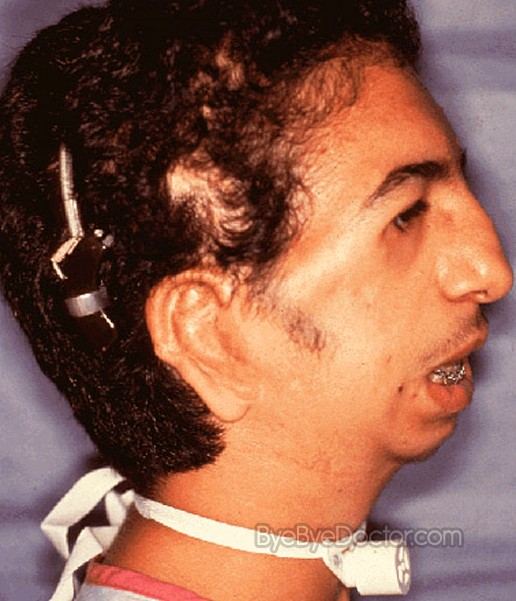Treacher Collins Syndrome
Last reviewed by Dr.Mary on August 7th, 2018.
What is Treacher Collins Syndrome?
This is a condition that is hereditary meaning that it is passed down thru family generations. It leads to defects of the face caused by a defective protein. This birth defect occurs in approximately 1 in every 10,000 births.
Treacher Collins Syndrome Symptoms
This syndrome which is also referred to as mandibulofacial dysostosis, affects bone development and other tissues in the head and face. Signs or symptoms vary greatly from individual to individual, ranging from hardly noticeable to quite severe. Some individuals with this syndrome are also born with cleft palate which is an opening in the roof of the mouth. In cases which are severe, the facial bones that are underdeveloped can restrict an infant’s airway, causing respiratory problems that are life-threatening.
Characteristics can include:
- Eyes are down-slanting
- Few eyelashes
- Lower eyelids are notched
- Eye abnormalities can lead to vision loss
- Large, beak-looking nose
- Obstructed or small nasal passages
- Absent or underdevelopment of cheekbones as well as the floor and side wall of socket of the eye
- Lower jaw that is often slanting and small
- Hairline is unusual with hair growing across the cheek like a sideburn
- Malformed or underdeveloped and/or prominent ears
- Defects in middle ear can lead to loss of hearing
- In some cases, very small or missing thumbs
Treacher Collins Syndrome Causes
This syndrome is caused by a protein called treacle that is defective. This condition is passed on thru families – inherited. More than half of the cases are believed to be caused by new gene mutations since there is no family history of the disorder.
Research that is recent has isolated the cause of this syndrome to a problem with a gene on the number 5 chromosome. This is the gene that controls the development of bones as well as other structures of the head and neck. When this gene is defective the bones in the facial area do not develop properly in the womb and the baby is born with facial features characteristic of this syndrome. These abnormalities vary from individual to individual, but often they will cause difficulties with breathing, eating as well as hearing.
Most children with this disorder pass milestones in development for instance beginning to talk and walk, at the normal time and are of normal intelligence but problems with hearing can impede learning. The majority need help with hearing aids that are specialized as well as speech therapy in order to develop language and speech.
This disorder is dominantly inherited, meaning that an individual who is affected has about a 50% chance of passing the disorder down to their children. Most individuals who have the disorder are able to trace this condition back thru parents and grandparents. But, children with severe problems will often have a parent who is affected only mildly and vice versa, so the disorder may have gone unnoticed.
Approximately 60% of individuals who are affected have no family history and the disorder is because of a new mutation to the gene. In these cases, there is only a slight chance that a 2nd child with this disorder will be born to these parents but the one child that is affected may pass the disorder down to their children.
Treacher Collins Syndrome Treatment
The treatment of Treacher-Collins syndrome is often lengthy and involves a multidiscipline approach that focuses on the treatment of symptoms. In newborns, immediate attention to swallowing and airway problems is critical. When there are severe problems and airway insufficiency is the main problem after birth, a tracheostomy is done and may stay until the lower jaw has grown sufficiently or until surgery is performed to allow air to pass thru the oral cavity. In some cases, special positioning of the baby may be enough to aid with this problem.
In babies with swallowing problems which are severe, introduce feeding by tube or even thru a gastrostomy tube may be needed in order to make certain that caloric intake and hydration is acceptable.
When the baby is born with substantial hearing loss, fitting with hearing aids as quickly as possible is important for the infant’s development of communication skills as well as the normal process of bonding with the family.
Reconstructive surgery can be offered to build up cheekbones, reconstruct the outer ear, correct the nose or an underdeveloped jaw.
Overcrowding of the teeth and other problems might require dental work as the child grows.
Family to family support is of great psychological value and is advised for all members of the family.
Treacher Collins Syndrome Facts
- Disorder is inherited and rare
- Can cause feeding difficulties
- Can cause speaking difficulties
- Other communication problems
- May cause vision problems
- Bilateral or symmetrical disorder – meaning same on both side of body
- Named for Edward Treacher Collins who first wrote about this condition in 1900
- Prevalence is 1 in every 10,000 births
- Occurs in both females and males
- Children with syndrome have normal intelligence
- Grow to be functional adults
- Best outcomes achieve with early intervention
- Normal life span




